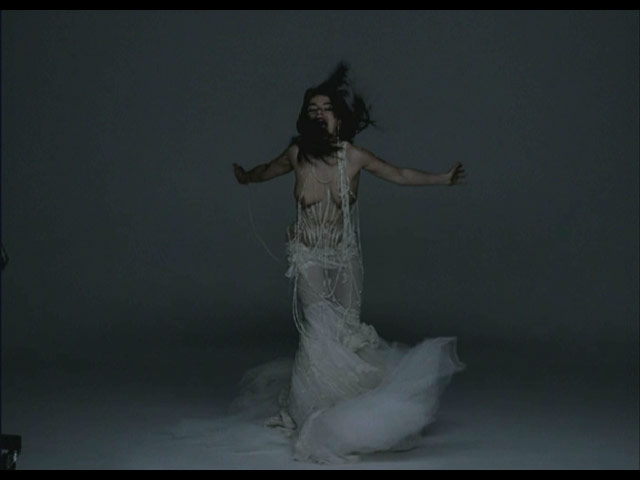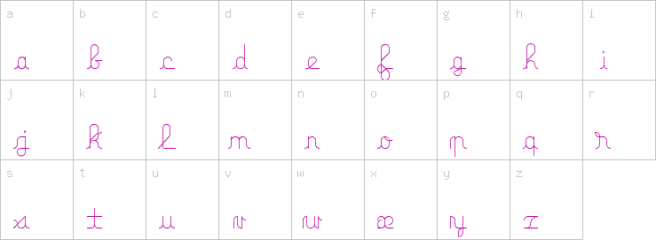“The stop point out, with truth, the time of pause
A sentence doth require at ev’ry clause.
At ev’ry comma, stop while one you count;
At semicolon, two is the amount;
A colon doth require the time of three;
The period four, as learned men agree”
Cecil Hartley
“On the page, punctuation performs its grammatical function, but in the mind of the reader it does more than that. It tells the reader how to hum the tune.”
Lynn Truss
Eats, Shoots and Leaves
Punctuation is historically an aid to reading aloud (vis George Bernard Shaw). Quite so, punctuation marks are symbols that indicate the structure and organization of written language, as well as intonation and pauses to be observed when reading aloud. The rules of punctuation vary with language, location, register and time and are constantly evolving. Certain aspects of punctuation are stylistic and are thus the author’s (or editor’s) choice.
In 2010, photographers Inez van Lamsweerde and Vinoodh Matadin collaborated with artists M/M Paris (an art and design partnership consisting of Mathias Augustyniak and Michael Amzalag) on a series of collages featuring various celebrities as punctuation marks as part of their Pretty Much Everything retrospective.
 Asterisk ( * )
Asterisk ( * )
From Greek: ἀστερίσκος, asteriskos, “little star”. The asterisk is a typographical symbol or glyph derived from the need of the printers of family trees in feudal times for a symbol to indicate date of birth. This symbol is used to call out a footnote, especially when there is only one on the page. Less commonly, multiple asterisks are used to denote different footnotes on a page (i.e., *, **, ***). Typically, an asterisk is positioned after a word or phrase and preceding its accompanying footnote. Asterisks are sometimes used as an alternative to typographical bullets to indicate items of a list. Asterisks are sometimes used as an alternative to typographical bullets to indicate items of a list.
Lewis Carroll‘s looking-glass world is divided into sections by brooks or streams, with the crossing of each brook usually signifying a notable change in the scene and action of the story: the brooks represent the divisions between squares on the chessboard, and Alice’s crossing of them signifies advancing of her piece one square. Most editions of the book visually represent the crossings by breaking the text with several lines of asterisks ( * * * ).
 Björk
Björk
 Slash ( / )
Slash ( / )
The slash goes back to the days of ancient Rome. In the early modern period, in the Fraktur script, which was widespread through Europe in the Middle Ages, one slash (/) represented a comma, while two slashes (//) represented a dash. The two slashes eventually evolved into a sign similar to the equals sign (=), then being further simplified to a single dash or hyphen (–). Is a sign used as a punctuation mark and for various other purposes. It is often called a forward slash (a retronym used to distinguish the slash from the backslash, “\”), and many other alternative names. The slash is most commonly used as the word substitute for “or” which indicates a choice (often mutually-exclusive) is present. The slash is also used to indicate a line break when quoting multiple lines from a poem, play, or headline; or in an ordinary prose quotation, the start of a new paragraph.

Vanessa Redgrave
 Period ( . )
Period ( . )
A full stop (British English, Hiberno-English, Australian English, and New Zealand English) or period (American English and Canadian English) is the punctuation mark placed to indicate the end of sentences. In the context of web addresses and computing in general, it is typically called a dot. In conversation, as opposed to linguistics, the term is often used to mean “the end of the matter” (for example, “We are calling a full stop to discussions on this subject” or “We will not do it. Period!”).
The full stop symbol derives from Aristophanes of Byzantium who invented the system of punctuation where the height of placement of a dot on the line determined its meaning. The high dot (˙) was called a “periodos” and indicated a finished thought or sentence, the middle dot (·) was called a “kolon” and indicated part of a complete thought, while the low dot (.) was called a “telia” and also indicated part of a complete thought.
 Mickey Rourke
Mickey Rourke
 Comma ( , )
Comma ( , )
Is used in many contexts and languages, principally for separating things. It has the same shape as an apostrophe or single closing quotation mark in many typefaces, but it differs from them in being placed on the baseline of the text. Some typefaces render it as a small line, slightly curved or straight but inclined from the vertical, or with the appearance of a small, filled-in number 9. It is used to separate parts of a sentence such as clauses and lists of three or more things.
In the 3rd century BC, Aristophanes of Byzantium invented a system of single dots (distinctiones) that separated verses (colometry), and indicated the amount of breath needed to complete each fragment of text, when reading aloud.
 Jim Jarmusch
Jim Jarmusch
 Open bracket ( ( )
Open bracket ( ( )
 Close bracket ( ) )
Close bracket ( ) )
Brackets are tall punctuation marks used in matched pairs within text, to set apart or interject other text. Used unqualified, brackets refer to different types of brackets in different parts of the world and in different contexts. Erasmus of Rotterdam coined the term lunula to refer to the rounded parentheses (), recalling the round shape of the moon.
 Bill Murray
Bill Murray
 Open guillemets ( « )
Open guillemets ( « )
Also called angle quotes or French quotation marks, are polylines, pointed as if arrows (« or »), sometimes forming a complementary set of punctuation marks used as a form of quotation mark. They are used in a number of languages to indicate speech. They resemble (but are not the same as) the symbols for lesser than (<), greater than (>), and for left and right bit shifts in some programming languages, as well as rewind and fast forward on various media players, such as VCRs, DVD players, and MP3 players. The word is a diminutive of the French name Guillaume (the equivalent of which in English is William), after the French printer and punchcutter Guillaume Le Bé (1525–98).
 Daniel Day-Lewis
Daniel Day-Lewis
 Colon ( : )
Colon ( : )
The colon is a punctuation mark consisting of two equally sized dots centered on the same vertical line.English colon is from Latin colon (plural cola), itself from Greek κῶλον “limb, member, portion”, in rhetoric or prosody especially a part or section of a sentence or a rhythmical period of an utterance. In palaeography, a colon is a clause or group of clauses written as a line. Use of the : symbol to mark the discontinuity of a grammatical construction, or a pause of a length intermediate between that of a semicolon and that of a period, was introduced in English orthography around 1600.
 Mia Farrow photographed for a Gap Ad
Mia Farrow photographed for a Gap Ad
 Semicolon ( ; )
Semicolon ( ; )
It is a punctuation mark with several uses. The Italian printer Aldus Manutius the Elder established the practice of using the semicolon to separate words of opposed meaning and to indicate interdependent statements. Modern uses of the semicolon relate either to the listing of items or to the linking of related clauses. A semicolon is used when a sentence could have been ended, but it wasn’t.
 Juliette Binoche
Juliette Binoche
 Exclamation ( ! )
Exclamation ( ! )
The exclamation mark is a punctuation mark usually used after an interjection or exclamation to indicate strong feelings or high volume (shouting), and often marks the end of a sentence. One theory of its origin is that it was a Latin exclamation of joy (io), written with the I above the o. The exclamation mark was first introduced into English printing in the 15th century, and was called the “sign of admiration or exclamation” or the “note of admiration” until the mid-17th century; admiration referred to its Latin sense of wonderment.
 Clint Eastwood
Clint Eastwood
 Question mark ( ? )
Question mark ( ? )
Also known as an interrogation point, interrogation mark, question point, query, or eroteme), is a punctuation mark that replaces the full stop (period) at the end of an interrogative sentence in English and many other languages. The question mark is not used for indirect questions. The question mark character is also often used in place of missing or unknown data.
The symbol is sometimes thought to originate from the Latin quaestiō (that is, qvaestio), meaning “question”, which was abbreviated during the Middle Ages to qo. The lowercase q was written above the lowercase o, and this mark was transformed into the modern symbol. However, evidence of the actual use of the Q-over-o notation in medieval manuscripts is lacking; if anything, medieval forms of the upper component seem to be evolving towards the q-shape rather than away from it.
 Natalie Portman
Natalie Portman
 Ampersand ( & )
Ampersand ( & )
It’s a logogram representing the conjunction word “and”. This symbol is a ligature of the letters et, Latin for “and”. The word ampersand is a corruption of the phrase “and (&) per se and”, meaning “and (the symbol &) intrinsically (is the word) and”. In film credits for stories, screenplays, etc., & indicates a closer collaboration than and.
 Björk in Oscar 2001 red carpet
Björk in Oscar 2001 red carpet Still from Pagan Poetry (Nick Knight, 2001) music video. She’s wearing a dress designed by Alexander McQueen. The music video “is about a woman preparing herself for marriage and for her lover”, Knight said.
Still from Pagan Poetry (Nick Knight, 2001) music video. She’s wearing a dress designed by Alexander McQueen. The music video “is about a woman preparing herself for marriage and for her lover”, Knight said.  Clifton Webb, Marlene Dietrich and Elizabeth Allen
Clifton Webb, Marlene Dietrich and Elizabeth Allen
 Morocco (Josef von Sternberg, 1930) Promotional pictures
Morocco (Josef von Sternberg, 1930) Promotional pictures





































